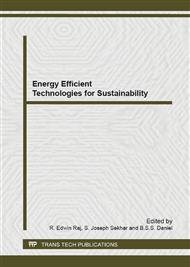p.64
p.70
p.75
p.80
p.84
p.90
p.98
p.103
p.109
Three Phase Hybrid 7-Level Inverter with 60 Degree PWM Scheme for PV Applications
Abstract:
In this paper, a hybrid multilevel inverter (MLI) with reduced number of components is modelled by deriving its source from solar PV array. The power switches of this MLI are controlled by utilizing the pulses derived by comparing the reference and carrier signal. The reference signal for the modulation process is based on 60 degree PWM. The carriers considered for the modulation process are triangular carrier wave and inverted sine carrier wave arranged in phase Disposition (PD) multicarrier method. The output voltage waveform of this hybrid MLI under consideration is analyzed with different performance parameters like Total Harmonic Distortion (THD), RMS Voltage, DC utilization Rate and harmonic spectrum. The simulation results show that the inverted sine based PD technique is yielding better performance than that of other technique. The above mentioned are examined with the help of MATLAB / SIMULINK.
Info:
Periodical:
Pages:
84-89
Citation:
Online since:
September 2013
Price:
Сopyright:
© 2013 Trans Tech Publications Ltd. All Rights Reserved
Share:
Citation:


